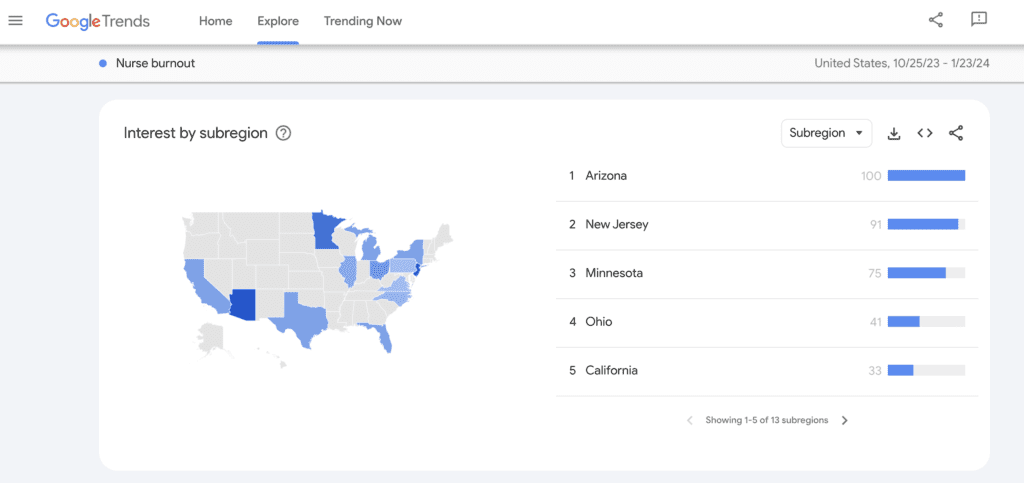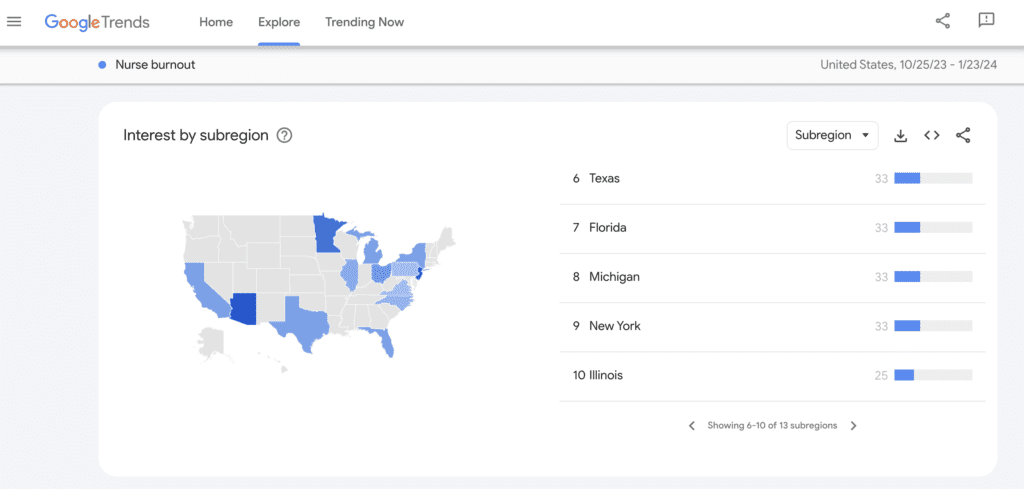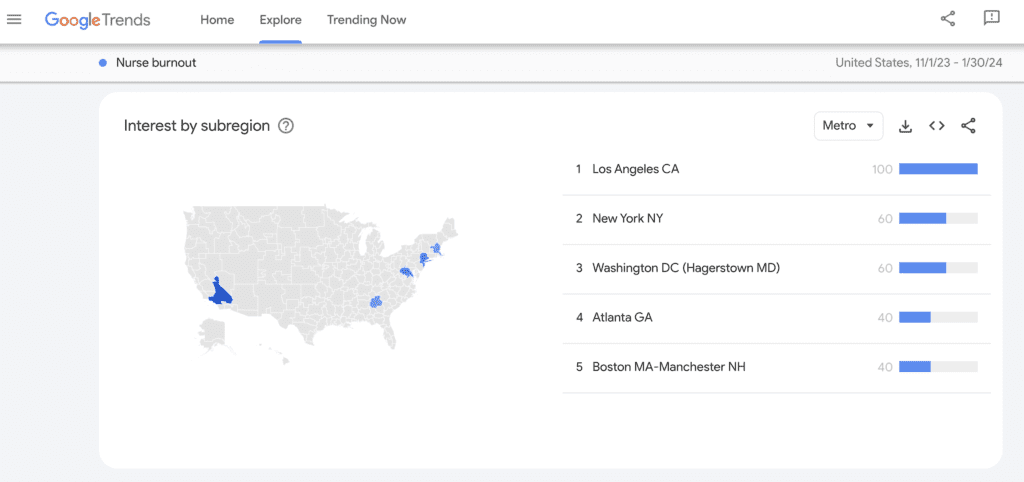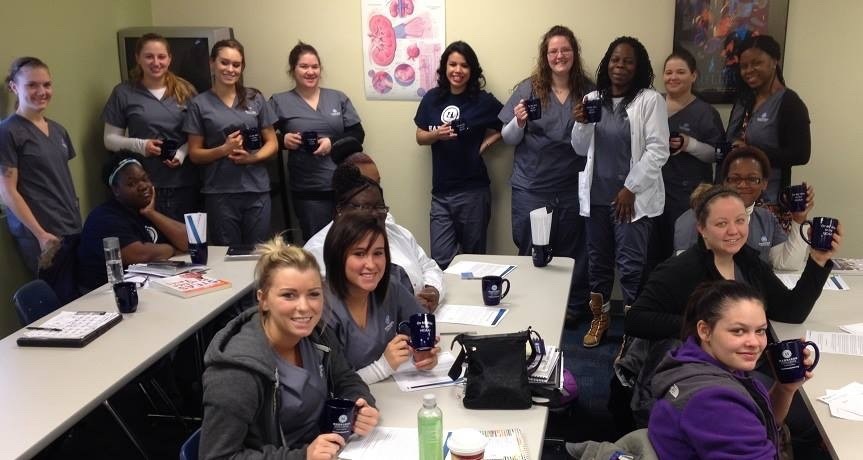Nurses stand on the frontline of healthcare, providing essential care that holds the delicate balance between life and death. Yet, beneath their resilient exteriors lies a growing crisis threatening not only their well-being, but also the quality of care they’re able to provide.
Nurse burnout, a pervasive issue exacerbated by the COVID-19 pandemic, has reached alarming levels across the United States. This has profound implications for nurses, their patients, and even the healthcare system at large.
So, in this article, we explore nurse burnout statistics, uncovering the states where and times when nurses feel the most strain. Through a combination of Google Trends data analysis, supplemental research, and expert insights, we aim to shed light on the magnitude of this issue.
Beyond the numbers, we explore the root causes of burnout, which often centers on understaffing and unmanageable workloads.
We also touch on some potential solutions to address it. From individual self-care strategies to systemic changes and legislative advocacy, we offer insight into how we can begin lessening the impact of nurse burnout.
Ultimately, we found that tackling this issue will require collective action and a profound commitment to change. So, join us as we analyze nurse burnout and consider how to build a more sustainable and supportive future for our healthcare heroes.
Table of contents
Key Nurse Burnout Statistics For 2024
The following are the high-level takeaways concerning nurse burnout in the United States. We delve deeper into these findings throughout this article.
- Arizona is the state where nurses are currently experiencing the highest levels of burnout
- Los Angeles, CA is the metro area where nurses are currently experiencing the highest levels of burnout
- In 2023, nurses experienced the highest levels of burnout during the week of November 26th to December 2nd
- Nurses reached the highest level of burnout in the last 5 years during the week of April 17 to April 23, 2022
- On average over the last 5 years, the month with the highest level of nurse burnout is November
- On average over the last 5 years, the week with the highest level of nurse burnout is the fourth week of the year (late January)
What Is Nurse Burnout?

Nurse burnout is a state of physical, emotional, and mental exhaustion caused by prolonged exposure to the stress of the nursing profession. It’s the result of a number of occupational factors, including:
- Understaffing
- High workloads
- Long hours
- The emotional intensity of patient care
- Lack of adequate support from employers
While not technically a medical condition, this occupational phenomenon is included in the 11th Revision of the International Classification of Diseases (ICD-11).
According to the World Health Organization (WHO), it’s characterized by the following three primary components.
Feelings of Energy Depletion and Exhaustion
Energy depletion and exhaustion are at the heart of burnout. Nurses frequently report feeling drained of physical and emotional energy due to:
- Demanding work schedules
- High patient loads
- The emotionally taxing nature of their work
This exhaustion extends beyond normal fatigue. In fact, it can manifest as a profound sense of tiredness that doesn’t improve with rest.
Increased Mental Distance From One’s Job
Nurses experiencing burnout often find themselves disengaged from their work.
Additionally, they may develop a negative or cynical attitude towards their job and the people they care for.
This detachment is not just an emotional response, but also a coping mechanism to deal with the overwhelming demands of their profession.
Reduced Professional Efficacy
Burnout can lead to a noticeable decline in the feeling of competence and achievement in one’s work.
This means nurses may begin to feel that they’re not effective in their roles, or that their work isn’t making a significant impact.
Overall, it can lead to a reduced sense of personal accomplishment, and can adversely affect the quality of care they provide.
10 States With The Most Nurse Burnout
To determine the states experiencing the most nurse burnout, we used data from Google Trends from October 21, 2023 to January 23, 2024 to gauge the relative search interest in the term “nurse burnout”.
Relative search interest doesn’t tell us the exact number of searches. Instead, it provides a comparative insight into how frequently people searched for the term in one area versus another during different times.
Each value is scaled from 0 to 100, where 100 represents the peak popularity for the term for the given region and time frame.
For instance, since Arizona shows a relative search interest of 100, it means that, relative to the size of its population and the time frame considered, searches for this term were more popular in Arizona than in any other state during the same period.


When a state has a higher relative search interest in the query, it indicates that nurses in that state are struggling with burnout more. This is because the search query “nurse burnout” suggests the searcher intends to look for ways to combat the stresses of the profession.
Keep in mind, however, that while search interest is a good indicator of the prevalence of nurse burnout, there are some limitations. Correlation does not always equate to causation. For example, awareness campaigns or media coverage could have an impact on search interest in each state.
Additionally, search behavior can vary regionally due to differences in Internet usage habits and population demographics.
Regardless of these limitations, however, nurse burnout is clearly a problem in each of the states below based on our supplemental research. This is why we provide some background, as well as links to reports, studies, and news articles, to further explain how burnout is affecting nurses in each state.
| State | Relative Search Interest In “Nurse Burnout“ |
| Arizona | 100 |
| New Jersey | 91 |
| Minnesota | 75 |
| Ohio | 41 |
| California | 33 |
| Texas | 33 |
| Florida | 33 |
| Michigan | 33 |
| New York | 33 |
| Illinois | 25 |
1. Arizona
The state with the highest level of nurse burnout is Arizona. According to Heidi Sanborn, President of the Arizona Nurses Association, this is due to multiple factors, including concerns over:
- Pay
- Stress
- Work-life balance
- A rise in bedside violence
Additionally, a key factor in burnout is a critical shortage of nurses. According to HealthData.gov, Arizona had the fourth most severe shortage as of May 2021.
Meanwhile, more recent data from Scholaroo reports that Arizona has the seventh-highest shortage of nurses in the country.
In fact, there are only 7.61 nurses available per capita. This is half the number of the state with the most available nurses, South Dakota, which boasts 15.78.
12news interviewed two Phoenix-based nurses reporting they were often caring for more than six patients at a time. Meanwhile, the recommended ratio is four patients at a time.
The outlet also stated that multiple Arizona health networks have reported similar shortages. For example, in 2022, Banner Health’s chief medical officer, Dr. Marjorie Bessel, said:
“Recently we have had to temporarily close some of our urgent care locations due to staff availability. This has resulted in longer wait times at the urgent cares that remain open.”
Worse yet, the Arizona Hospital and Healthcare Association predicts that Arizona will have the largest nursing shortage by 2025. Projections show the state will have 28,100 fewer registered nurses than it requires.
Fortunately, however, the state is taking measures to mitigate its critical shortage, and hopefully lessen nurse burnout.
In 2023, the Arizona Board of Nursing launched the “ARS 36-1803 Grant: Nurses For A Healthy Arizona“. This program provides $25 million in annual funding for three years to expand preceptor training programs.
It’s projected to add 1,145 new preceptors, as well as 460 new nursing students.
2. New Jersey
New Jersey has the second-highest level of nurse burnout. In fact, Scholaroo reports the Garden State has just 8.46 nurses available per capita, making it one of the states with the greatest need for more nurses in the northeast.
According to a March 2023 report by Health Professionals and Allied Employees (HPAE), “nearly a third of nurses have left the bedside (hospitals) in the past three years.” Of those remaining, a staggering 72% have considered leaving the profession recently.
To make matters worse, 95% of those who left are newer nurses with less than five years of experience.
HPAE reports that the top two reasons for leaving are understaffing and stress/burnout, which, of course, go hand in hand.
Currently, New Jersey only has staffing regulations for CCU’s and ICU’s. However, even these regulations are inadequate. The industry recommendation for these types of units is one nurse to two patients. Existing regulations require one nurse for every three patients.
One nurse, Judy Danella, said in an interview with NJ Spotlight News, “There is no nursing shortage. There is a staffing crisis.” According to her, there are 5,600 nurses in New Jersey currently not practicing.
However, more manageable patient loads could help bring them back. This has led nurses at some hospitals to strike.
After a nearly five-month strike against RWJUH in New Brunswick in December 2023, nurses got mandated staff-to-patient ratios included in their contract.
Meanwhile, others are advocating for statewide legislation to establish patient ratio mandates. However, some are opposed to these mandates. Cathy Bennett, president and CEO of the New Jersey Hospital Association, told NJ Spotlight News:
“Mandated ratios may lead hospitals to temporarily or permanently [shut] health services in obstetrics, dialysis, cancer or pediatric care. This directly impacts patients and may at times be life threatening.”
3. Minnesota

While Scholaroo reports that Minnesota has the seventh largest number of RNs per capita, it ranks number three for nurse burnout. At 11.16 nurses per capita, it still lags behind states like South Dakota with 15.78.
In fact, 2,400 nurses in the state left the bedside in the year preceding the Minnesota Nurses Association’s 2023 report titled “Why We Left”. The report surveyed 500 of these nurses and found the top reasons for nurses leaving the profession were:
- Stress and Burnout (75%)
- Chronic Understaffing (71%)
- Working Conditions (63%)
- Management Issues (49%)
Though clinical staffing vacancies in the state are still far above the 6% reported pre-pandemic, Star Tribune states that vacancies dropped from 19% to 17% from 2022 to 2023.
However, it’s important to remember understaffing isn’t the only contributor to burnout. For example, Minnesota Reformer writes of one nurse’s experience with inadequate resources:
“During her last shift, a patient had an unwitnessed seizure in the lobby, but there were no empty beds. After seizing, the patient was alert, so Daiello told them to wait on the floor. While this advice had the patient’s best interest in mind, she knew it was not ideal.”
After this 12-hour shift, the nurse in question crashed her car on the way home, despite there hardly being any other cars on the road.
The silver lining of the MNA report mentioned earlier is that 80% of nurses who left the bedside said they were willing to return if hospital conditions improved.
Additionally, legislators enacted the Nurse and Patient Safety Act, focusing on workplace violence prevention, burnout, and loan forgiveness. However, last-minute negotiations prevented staffing level regulations.
4. Ohio
Like Minnesota, Ohio is one of the states with a large number of available nurses per capita, as Scholaroo ranks them eighth with 11.09. Despite this, many nurses still report their hospitals are critically understaffed.
Though Becker’s Hospital Review reports Ohio is projected to have the third-highest overage of RNs by 2030, hospitals aren’t hiring enough nurses for manageable patient ratios.
In fact, according to the Ohio Nurses Association’s Code Red campaign:
“… One of the main issues is that nurses are leaving the bedside due to deplorable working conditions and moral injury caused by short staffing because of workload.”
Additionally, Code Red claims that better pay would help in retaining registered nurses, particularly in rural areas where nurses are harder to hire.
Many nurses in the state also echoed the problem of short staffing. For example, a registered nurse at OSU James Cancer Hospital interviewed by WFMJ, Catharyne Henderson, said:
“The workload of course has doubled, if not tripled, which has significantly increased the burnout, the moral injury and the stress accounting for the majority of the staff leaving.”
ONA also conducted a survey in which they found:
- 58.05% of nurses left the bedside because of patient load
- 70.09% are currently considering leaving the bedside due to patient load
- 88.79% would consider staying at bedside if Ohio had legally-enforceable minimum staffing standards
- 42.80% would consider returning to bedside if the state implemented minimum staffing standards
Fortunately, Ohio House Bill 285, the Nurse Workforce and Safe Patient Care Act, was introduced in the state’s legislature in September 2023. The bill is intended to create minimum staffing standards for nurses.
However, as of February 2024, the legislation has been referred to the Health Provider Services Committee, and has seen no further action since October 3, 2023.
5. California
Similar to many other states in the Southwest, California has one of the lower numbers of nurses per capita. In fact, Scholaroo reports they rank number 37th with 8.34.
Additionally, Los Angeles is the metro area with the highest level of nurse burnout.

Google Trends data from November 1, 2023 to January 30, 2024 (collected on January 31, 2024)
In 2023, nurses at Garfield Medical Center, located in the LA metro area, went on strike due to high turnover. The facility was chronically understaffed, causing many RNs to leave for other jobs with better conditions and pay. This resulted in burnout for the nurses that remained, ultimately leading to the strike.
Similar to some other states on this list, California has more of a staffing problem than nurse shortage. According to a report by National Nurses United, 150,000 of the 507,000 RNs with active licenses are not working as RNs.
Interestingly, California does have a law mandating specific nurse-patient ratios. Facilities can face a fine of $15,000 for their first violation, and $30,000 for subsequent violations. However, the enforcement of these ratios can be challenging.
Anita Girard, chief nursing officer at Cedars-Sinai in LA, told Becker’s Hospital Review:
“I do think that ratios have made a positive difference upon patient care and nursing satisfaction… I want to point out, though, that even trying to maintain the mandated ratio of 1-to-5 on a medical/surgical unit is difficult with the intense acuity of our patient populations.”
Becker’s also reported on nurses sounding the alarm on staffing problems at six different healthcare facilities in California. This included facilities in Los Angeles, San Diego, and San Francisco.
Ashley Hooks, a nurse at Lakewood Regional Medical Center, said these issues are so bad that the number of nurses at her hospital dropped from 500 to 330 from the beginning of Covid-19 to July 2023.
6. Texas

In Scholaroo’s nursing shortage report, the Lone Star state is 43rd in the nation, with just 7.69 nurses available per capita.
In fact, according to a 2022 report by the Texas Center for Nursing Workforce Studies, the RN position vacancy rate increased from 5.9% in 2019 to 17.6% in 2022. Worse yet, there’s an expected deficit of 16% by 2032, equivalent to 57,012 nurses.
Additionally, the turnover rate for registered nurses in Texas hospitals was 28.3% in 2022.
According to Texas A&M International University, the shortage is exacerbated by Texas’ rapidly growing population. As of the end of 2022, the population had grown by 470,000 since July 2021. This makes it the fastest-growing state in the nation, and means its total population now exceeds 30 million. Only California has more residents.
These big gains in population, coupled with longer life expectancy and more complex conditions, is expanding the need for care.
Texas has taken some measures to address short staffing and burnout, however. One example is the 2009 Texas Safe Hospital Staffing Act, which mandates the creation of nurse staffing committees within hospitals.
Additionally, the state implemented other programs to lessen the impact of the nurse shortage, including:
- Nursing Shortage Reduction Program (NSRP)
- Nursing Faculty Loan Repayment Assistance Program (NFLRP)
- Nursing Innovation Grant Program (NIGP)
While these investments in nursing programs are a good start, there are limitations. Serena Bumpus, president of the Texas Nurses Association, said:
“We can continue to churn nurses out of nursing schools all day long, however, if the work isn’t done inside the organization to foster a healthy work environment, we will continue to see nurses leave the bedside… It has to happen on both ends.”
7. Florida
Scholaroo reports that Florida ranks 32nd for total available nurses per capita with 8.88.
Like Texas, Florida is experiencing a nursing shortage exacerbated by a rapidly-growing population. In fact, it’s the third-largest state and second-fastest growing state, adding over 365,000 new residents from July 2022 to July 2023.
By 2033, the population is projected to increase by 13.7% to 25.34 million. To make matters worse, according to the 2023 Florida Hospital Association Workforce Report, 17% of the population is 65 years or older. The aging population will further increase the demand for care.
Furthermore, Health News Florida reports these staggering shortage and nurse burnout statistics:
- Nearly two-thirds of nurses witnessed inexperienced/unqualified personnel providing care because of short staffing
- Almost 9 in 10 nurses worked in a setting they felt was understaffed
- 51 percent of nurses report having anxiety or depression
Understaffing and burnout reached an extremely critical level in August 2022 at many facilities. Tampa Bay Times reports that 15 hospitals run by BayCare in Tampa Bay had vacancy for one in four nursing positions.
Fortunately, however, Florida has seen some improvements over the last year. According to a report by FHA, from 2022 to 2023, the state’s vacancy rate decreased from 21% to 13%, a 38% decrease.
Meanwhile, during the same time period, the turnover rate decreased from 32% to 20%, also a 38% decrease. In fact, the turnover rate nearly returned to pre-pandemic levels.
Still though, the report projects a shortfall of 59,100 nurses (37,400 RNs and 21,700 LPNs) by 2035.
To combat the nursing burnout and shortage, the Keiser University Nursing Advisory Council made several legislative recommendations. Two of these included providing supplementary higher-education voucher grants and bolstering the LINE initiative.
8. Michigan
While Scholaroo reports Michigan ranks relatively well for the number of nurses available per capita at 17th with 10.11, understaffing and burnout are still critical problems.
Jamie Brown, president of the Michigan Nurses Association, estimates there are 50,000 nurses with active licenses not practicing in the state. Meanwhile, Michigan Health and Hospital Association reported there are only about 8,500 nursing job openings.
Christopher Friese, professor of nursing at the University of Michigan and director of the Center for Improving Patient and Population Health, told Michigan Public:
“We actually have plenty of nurses, both in Michigan and the United States… Facilities, for quite some time, have really worked on a model of what is the bare minimum amount of nurse staffing that they need to keep the lights on, so to speak.”
To make matters worse, the staffing crisis could deteriorate further. According to an April 2023 University of Michigan study, about 39% of nurses in the state said they plan to leave their jobs in the next year.
The survey also found that 84% of nurses reported emotional exhaustion.
Meanwhile, another survey commissioned by the Michigan Nurses Association found “42% of nurses said they know of a patient death attributed to nurses being assigned too many patients in 2023.” That’s double the rate of a similar 2016 survey.
Fortunately, some nursing activists are taking action, like advocating for the Safe Patient Care Act. The legislation includes several bills intended to:
- Limit nurse-patient staffing ratios (HB 4550 and SB 334)
- End forced overtime (HB 4551 and SB 335)
- Require hospitals to disclose their staffing ratios publicly (HB 4551 and SB 335)
However, the MHA has explicitly opposed this legislation. They claim the bills have the “potential to severely harm hospitals and access to important services for patients.”
9. New York

The Scholaroo report ranks New York 25th for the total number of nurses available per capita at 9.68. Additionally, the New York Metropolitan area is the metro area with the second-highest level of nurse burnout.
In fact, NYC Health + Hospitals, which operates public hospitals and clinics in New York City, saw a 6% decrease in RN employment from February 2020 to September 2022. Meanwhile, the number of LPNs decreased by 31%.
Furthermore, a 2020 Department of Health report estimates New York will experience a shortage of over 39,000 nurses by 2030.
Part of the problem is insufficient education infrastructure. A June 2023 report by the Center for Health Workforce Studies concluded that about 15% of full-time nursing education faculty positions in the state were vacant in 2022.
Also, nearly half of deans reported turning away qualified applicants due to “admission caps, faculty vacancies, and lack of clinical training slots.”
However, according to Nancy Hagans, president of the New York State Nurses Association:
“The main problem in New York is not that we don’t have enough nurses to meet demand – there are thousands of nurses in New York who just don’t want to take hospital jobs.”
Now, there have been some successes in passing legislation aiming to lessen burnout and improve staffing levels.
For example, a regulation passed in June 2023 protects nurses from working mandatory overtime. Additionally, New York hospitals are now required to assign one nurse to no more than two patients in critical care units. They are also required to establish clinical staffing committees.
Unfortunately, however, the implementation and enforcement of these regulations has been subpar. In fact, the New York State Nurses Association found several instances where units were understaffed over 90% of the time.
10. Illinois
Illinois is the state with the tenth-highest level of nurse burnout. While it ranks pretty well in Scholaroo’s report of states with the largest number of available nurses at 15th with 10.28 per capita, understaffing and burnout are still critical problems.
According to the National Council of State Boards of Nursing, Illinois currently has 238,041 licensed RNs. However, as of 2022, BLS reports that the state only employed 139,590 nurses. This means there are about 88,000 registered nurses with active licenses not practicing.
As echoed in many other states, National Nurse United says it’s “not a shortage of nurses; it’s a staffing crisis.”
Worse yet, a 2020 Illinois Workforce Center report projects that the state will be short 15,000 RNs by 2025. Meanwhile, 52% of current RNs are over the age of 55, and 27% plan to retire within the next five years.
Furthermore, the state graduates fewer than 8,000 new nurses every year. According to Senator Dick Durban, in 2020, “there were 94 vacant full-time nurse faculty positions” across 38 colleges.
Unfortunately, precise data regarding the Illinois nurse staffing crisis is rather sparse, with few official studies. However, the state did enact a law directing the Nursing Workforce Center to address the problem. The measure requires the organization to collect a biennial “nurse demand and employer survey” by 2027.
Additionally, two legislators introduced the Safe Patients Limit Act, which would impose mandatory patient-to-staff ratios statewide. However, the measure has failed to gain much traction, and hospital lobby groups strongly oppose it.
Other reforms have added $700 million in incentives for facilities to increase pay and hire more staff. Before the reforms, “Illinois was home to 46 of the 100 worst-staffed nursing homes in the country”. That number has now dropped to 14.
When Do Nurses Experience The Most Burnout?

Google Trends weekly data from February 3, 2019 to January 21, 2024 (collected on January 31, 2024)
In addition to determining where nurses experience the highest level of burnout, we also determined when they experience the highest levels of burnout.
We found that since February 2019, the week where nurses experienced peak burnout was the week of April 17-23, 2022.
This time period, of course, followed about two years of constant exposure to the challenging circumstances of the Covid-19 pandemic.
On April 13, 2022, the NCSBN released a report titled “Examining the Impact of the COVID-19 Pandemic on Burnout & Stress Among U.S. Nurses”. The most notable finding from the report was that about 100,000 RNs had left the workforce in the previous two years due to stress, burnout, and retirements.
Other key findings from the report included:
- 62% of nurses surveyed reported that their workload increased during the pandemic
- Over 610,000 RNs (about one-fifth of the workforce) intend to leave the workforce by 2027 due to stress, burnout, and retirement
- Nurses reported feeling emotionally drained (50.8%), used up (56.4%), fatigued (49.7%), burned out (45.1%), or at the end of the rope (29.4%) a few times a week or every day.
NCSBN’s research also indicated that younger and less experienced nurses were especially affected by the high workloads and burnout during the pandemic.
Worse yet, high levels of turnover during Covid-19 disrupted pre-licensure nursing programs. This has “raised concerns about the supply and clinical preparedness of new nurse graduates.”
Furthermore, early career data cited in the report suggested “decreased practice and clinical proficiency” among those new to the profession.
So, while burnout may have reached its absolute 5-year peak in April 2022, it’s still a critical issue which could worsen as more RNs leave the workforce. Getting new and well-trained nurses to enter the profession will be vital for the success of US healthcare in the coming years.
Months With The Highest Levels of Nurse Burnout
| Month | Average Relative Search Interest In “Nurse Burnout“ |
| November | 58.43 |
| April | 56.24 |
| September | 56.05 |
| October | 53.74 |
| February | 52.85 |
We were also able to determine the months during which nurses tend to experience the highest levels of burnout each year.
To do so, we analyzed the weekly relative search interest in the term “nurse burnout” from February 2019 to January 2024. We then computed the average burnout level for each month across all years to determine the months with most consistent levels of burnout.
Overall, we found that November was, on average, the month with the highest level of nurse burnout over the last five years.
Below, we present the top five months when nurses experience the most burnout. We also explain some possible factors that may influence why these months have such high burnout levels.
- November: This month includes Thanksgiving which could increase workloads in hospitals due to accidents, emergencies, and possibly staff shortages as some nurses take leave.
- April: This month can be stressful due to factors like the start of allergy season, increasing patient load in some areas. It also sometimes includes Easter, which can affect staffing and workload.
- September: This period often marks the end of summer and the beginning of the school year, when nurses who are parents may need to adjust to school schedules. Additionally, stress and workload may increase due to seasonal illnesses.
- October: The flu season often begins in October, leading to an increase in patient admissions and nurse workload.
- February: This month is in the midst of winter, which is typically the flu and cold season, leading to higher patient volumes.
Weeks With The Highest Levels Of Nurse Burnout
| Week | Average Relative Search Interest In “Nurse Burnout“ |
| Week 4 (End of January) | 63.25 |
| Week 11 (Mid-March) | 61.80 |
| Week 45 (Early November) | 60.60 |
| Week 48 (Late November) | 60.40 |
| Week 39 (Late September/Early October) | 60.40 |
Finally, we determined the weeks during which nurses tend to experience the highest levels of burnout each year.
Like our monthly analysis, we used weekly relative search interest data from February 2019 to January 2024. Then, we calculated the average nurse burnout levels across all weeks in the dataset.
Overall, we determined that the fourth week of the year, the end of January, had the highest level of burnout over the last five years.
Below, we present the top five weeks during which nurses tend to experience the most burnout. We also include some possible factors that may contribute to burnout during these weeks.
- Week 4 (End of January): Post-holiday season fatigue, coupled with potential staffing issues and ongoing winter illnesses, might contribute to higher burnout levels.
- Week 11 (Mid-March): This week often falls around Spring Break, which could lead to increased accidents and emergencies, affecting nurse workload.
- Week 45 (Early November) and Week 48 (Late November): These weeks are close to Thanksgiving, which, as mentioned, can significantly impact nurse workload.
- Week 39 (Late September/Early October): This is a transitional period between seasons, where changes in weather can influence health conditions, increasing the demand for healthcare services.
How To Address Nurse Burnout

Reducing burnout amongst nurses across the nation will require a multi-pronged approach. Individual nurses, healthcare facilities, activists, and states all need to take action.
First of all, individual nurses can take precautions to safeguard their mental health and achieve a manageable work-life balance. Some steps nurses might consider taking include:
- Prioritizing self-care
- Seeking support from mental health professionals
- Setting clear boundaries between work and personal life
- Connecting with peers and building or joining a support network
- Engaging in professional development and/or pursuing non-bedside positions
If you’re a nurse struggling with burnout or know one who is, you may also want to check out these books for burnt-out nurses.
Of course, nurses can only do so much on the individual level to combat stress and burnout. As we’ve seen throughout this article, understaffing and unmanageable patient loads are key drivers of nurse burnout.
To address understaffing, healthcare facilities might consider implementing mandatory nurse-to-patient ratios.
While many hospitals seem reluctant to do so, advocating for legislation at the state level could also help to implement these changes.
Additionally, at the federal level, the Nurse Staffing Standards for Hospital Patient Safety and Quality Care Act would introduce minimum RN-to-patient ratios across the country. The bill also calls for whistleblower protections so nurses are free to speak out on safe staffing requirement breaches.
Other actions that healthcare facilities may consider include:
- Promoting mental health resources
- Offering flexible scheduling
- Investing in nurse education and training
- Addressing workplace violence
Ultimately, however, advocating for effective legislation will likely be a key factor in addressing the problem of nurse burnout.
Conclusion
As we’ve explored the complex landscape of nurse burnout across the United States, it’s clear that this issue is not just a matter of individual well-being. Instead, it’s a critical challenge facing our entire healthcare system.
The stories from states as diverse as Arizona, New Jersey, and Minnesota underscore a nationwide crisis demanding a comprehensive response. Meanwhile, the data and personal accounts we’ve examined reveal the profound effects of burnout on nurses’ health, patient care quality, and the overall efficiency of our healthcare institutions.
Addressing nurse burnout requires a concerted effort at all levels of healthcare. This includes individual nurses practicing self-care and seeking support, healthcare facilities implementing better staffing policies, and lawmakers enacting and enforcing standards to protect nurses.
The path forward involves not only recognizing the signs of burnout, but actively working to create an environment where nurses can thrive, not just survive. Advocates, healthcare professionals, and policymakers should take these findings as a call to action.
Nurse burnout is more than just a statistic; it’s a signal that our healthcare system needs to evolve. After all, the health of our nurses is indispensable to the health of our nation.

Nurse Luke is a CRNA who specializes in Nursing content and still enjoys a very busy career with Locum, Per Diem and Travel nursing in the greater midwest. He has over 25 years of experience in the healthcare field and received his CRNA masters degree from the Mayo Clinic School of Healthcare. He is passionate about helping nurses explore the options of becoming a travel nurse as well as spending time with his Family.



